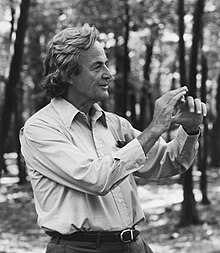Our website is made possible by displaying online advertisements to our visitors.
Please consider supporting us by disabling your ad blocker.
Richard Feynman

Richard Feynman (11 May 1918 – 15 February 1988) was an American physicist of Jewish descent. He was part of the Manhattan Project team that made the atomic bomb. Feynman won the Nobel Prize in Physics 1965. He was one of the first people to study quantum physics. Feynman added significantly to a branch of science called quantum electrodynamics and invented the Feynman diagram. He was also one of the first scientists to discuss about the possibility of quantum computers.[1][2]
During World War II, Feynman worked on the Manhattan Project at Princeton University and Los Alamos National Laboratory. At age 24, he was the youngest group leader in the theoretical division and helped create the formula for predicting the energy yield of a nuclear bomb.[3][4]
In 1986, Feynman joined the Rogers Commission Report to investigate the causes of the Space Shuttle Challenger disaster.[5] Feynman's role in the commission was said to have helped it discover the reasons behind the explosion.[5]
- ↑ Nielsen, Michael A.; Chuang, Isaac L. (2010). Quantum Computation and Quantum Information (10th anniversary ed.). Cambridge: Cambridge University Press. p. 7. ISBN 978-1-107-00217-3. OCLC 844974180.
- ↑ Rieffel, Eleanor G.; Polak, Wolfgang H. (March 4, 2011). Quantum Computing: A Gentle Introduction. MIT Press. p. 44. ISBN 978-0-262-01506-6.
- ↑ "Richard Feynman". Laphams Quarterly. Retrieved October 14, 2024.
- ↑ "Richard Feynman (1918 - 1988)". Hiroshima Remembered. Retrieved November 4, 2024.
- ↑ 5.0 5.1 "How Legendary Physicist Richard Feynman Helped Crack the Case on the Challenger Disaster". Lithub. Retrieved October 14, 2024.
Previous Page Next Page


